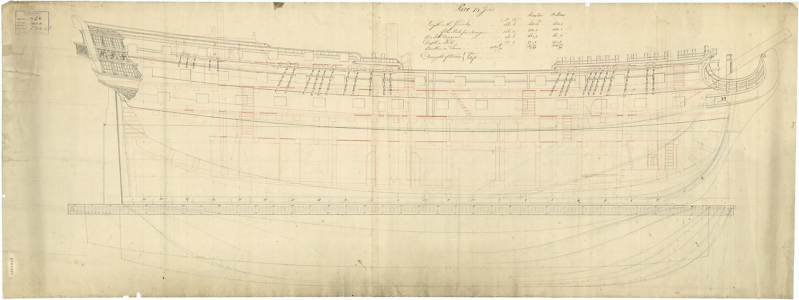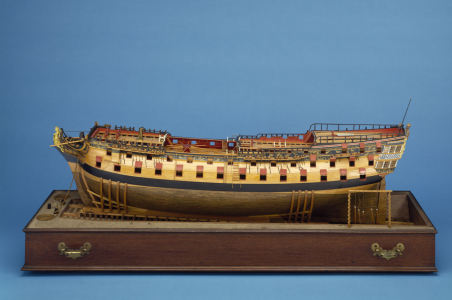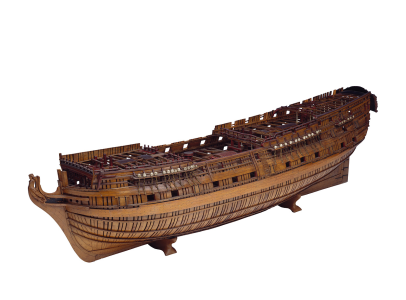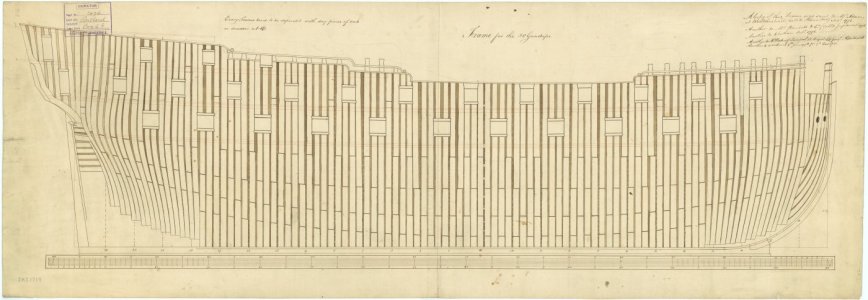The Enterprise Bellona build that may never start
Back in 1978 I promised myself that someday I would build another model, this time plank on frame.
So here I am, 77 years of age, contemplating if this will ever happen. At the moment I am “helping” a six year old boy build Occre’s Bounty Boat. Looking for guidance I stumbled across Ships of Scale (SOS). While browsing I stumbled upon and was quite enamored by the San Felipe. I began looking for drawings only to discover that the ship never existed. With this set back I realized I wasn’t sure what I wanted to build. My wife was pushing for “something pretty.”
I never really finished my first big ship, Norske Love. The drawings provided did not show how the yards were attached to the masts. As much research as I was able to do, I was never able to answer the question to my satisfaction. Contemplating this I realized a few things. It had to be a real ship. Some hull drawings had to be available, as did basic rigging plans. In summary a near historic model, preferably a named ship. Lastly a hull about 26 to 30 inches in length
So armed, I began looking at ships. I’m not sure how the list grew but grow it did. I looked at drawings and kits for 15 or so ships (see list and comments below). Early on I found HMS Enterprise. I was to gather up the Greenwich drawings as well as a set of commercial drawings. Pouring over the body plan I realized that I did not know how the ship was built. There is a wealth of knowledge on this site but I wasn’t been able to turn any of it into probable British Navel building practice in the mid to late 1700s .
Sutherland’s “The Ship-Builders Assistant” is much too early. Steel’s “The Shipwright’s Vade-Mecum” does not seem to supply details. Tables and such but no images. Frustrated, I began to look at other ships and buy books as I found them referenced in build logs.
Candidates:
HMS Cruizer – Sloop, 1752. Very simple stern, too simple
HMS Ontario – Snow, 1780. 22 guns. Simple stern, ship wreck located in lake Ontario
https://www.shipwreckworld.com/arti...discover-1780-british-warship-in-lake-ontario. Might pay to re-look.
HMS Prince – 1670, first rate, too elaborate.
Santa Anna – Spanish ship, 1784, 112 guns. Stern, although simple, is ugly.
Santisima Trinidad – Spanish ship, 1769, 130 guns. Too elaborate for me.
HMS Venus – 1758 5th rate frigate, 36 guns. Only painting and lines available.
HMS Victory – 1737 1st rate ship, 100 guns. Ship exists, Drawings aplenty. Too fancy.
HMS Royal William – 1719 1st rate ship, 100 guns. Too elaborate.
Montebello 1812 – French ship, 112 guns. A bit boring in profile.
Salvador del Mundo - Spanish ship 1787, 112 guns. Too big
HMS Bellona – 1760 3rd rate ship, 76 guns. Book available, can I handle the carving?
https://www.sailsofglory.org/entry.php?53-HMS-Bellona. Image of model available. Also: https://shipsofscale.com/sosforums/...ona-anatomy-of-the-ship-by-brian-lavery.2210/
HMS Leopard – 1790 Portland class, 50 gun, 4th rate. No rigging plans. No bulwarks so no place to tie off lines. Cannot build quasi historical
HMS Bristol - 1775 Portland class 50 gun ship. See HMS Leonard.
HMS Bedford - 1775 3rd rate 74 gun ship. Plan and model available
HMS Pandora – 1779 24 gun 6th rate ship
What to do? I have acquired McCarthy’s book “Building Plank – on – Frame Ship Models.” I was contemplating building a Cruiser class ship until he observed no stern drawings are available. Back to square one but I can now see how the ships might have been built. I also have other books that add to the knowledge.
Back to the Enterprise. Not sure I am up to all of the carving. There is more than on Bellona.
Have just reviewed Lovery’s book “The 74-gun ship Bellona.” There is quite a bit of information with sources given for the information. Bellona wins out.
Next step, study Lovery’s book.
Back in 1978 I promised myself that someday I would build another model, this time plank on frame.
So here I am, 77 years of age, contemplating if this will ever happen. At the moment I am “helping” a six year old boy build Occre’s Bounty Boat. Looking for guidance I stumbled across Ships of Scale (SOS). While browsing I stumbled upon and was quite enamored by the San Felipe. I began looking for drawings only to discover that the ship never existed. With this set back I realized I wasn’t sure what I wanted to build. My wife was pushing for “something pretty.”
I never really finished my first big ship, Norske Love. The drawings provided did not show how the yards were attached to the masts. As much research as I was able to do, I was never able to answer the question to my satisfaction. Contemplating this I realized a few things. It had to be a real ship. Some hull drawings had to be available, as did basic rigging plans. In summary a near historic model, preferably a named ship. Lastly a hull about 26 to 30 inches in length
So armed, I began looking at ships. I’m not sure how the list grew but grow it did. I looked at drawings and kits for 15 or so ships (see list and comments below). Early on I found HMS Enterprise. I was to gather up the Greenwich drawings as well as a set of commercial drawings. Pouring over the body plan I realized that I did not know how the ship was built. There is a wealth of knowledge on this site but I wasn’t been able to turn any of it into probable British Navel building practice in the mid to late 1700s .
Sutherland’s “The Ship-Builders Assistant” is much too early. Steel’s “The Shipwright’s Vade-Mecum” does not seem to supply details. Tables and such but no images. Frustrated, I began to look at other ships and buy books as I found them referenced in build logs.
Candidates:
HMS Cruizer – Sloop, 1752. Very simple stern, too simple
HMS Ontario – Snow, 1780. 22 guns. Simple stern, ship wreck located in lake Ontario
https://www.shipwreckworld.com/arti...discover-1780-british-warship-in-lake-ontario. Might pay to re-look.
HMS Prince – 1670, first rate, too elaborate.
Santa Anna – Spanish ship, 1784, 112 guns. Stern, although simple, is ugly.
Santisima Trinidad – Spanish ship, 1769, 130 guns. Too elaborate for me.
HMS Venus – 1758 5th rate frigate, 36 guns. Only painting and lines available.
HMS Victory – 1737 1st rate ship, 100 guns. Ship exists, Drawings aplenty. Too fancy.
HMS Royal William – 1719 1st rate ship, 100 guns. Too elaborate.
Montebello 1812 – French ship, 112 guns. A bit boring in profile.
Salvador del Mundo - Spanish ship 1787, 112 guns. Too big
HMS Bellona – 1760 3rd rate ship, 76 guns. Book available, can I handle the carving?
https://www.sailsofglory.org/entry.php?53-HMS-Bellona. Image of model available. Also: https://shipsofscale.com/sosforums/...ona-anatomy-of-the-ship-by-brian-lavery.2210/
HMS Leopard – 1790 Portland class, 50 gun, 4th rate. No rigging plans. No bulwarks so no place to tie off lines. Cannot build quasi historical
HMS Leopard; 50 Gun 4th Rate; 1790 - Scratch build 1:80
Hi Uwe, When I saw the mistake I also saw this:- "Once your birthday has been entered, it cannot be changed. Please contact an administrator if it is incorrect." I could only see the "Contact Us" and clicked on that and used the messaging service there -- so, how do I do it by "@Donnie" ...
shipsofscale.com
HMS Bristol - 1775 Portland class 50 gun ship. See HMS Leonard.
HMS Bedford - 1775 3rd rate 74 gun ship. Plan and model available
HMS Pandora – 1779 24 gun 6th rate ship
What to do? I have acquired McCarthy’s book “Building Plank – on – Frame Ship Models.” I was contemplating building a Cruiser class ship until he observed no stern drawings are available. Back to square one but I can now see how the ships might have been built. I also have other books that add to the knowledge.
Back to the Enterprise. Not sure I am up to all of the carving. There is more than on Bellona.
Have just reviewed Lovery’s book “The 74-gun ship Bellona.” There is quite a bit of information with sources given for the information. Bellona wins out.
Next step, study Lovery’s book.








 , which has a LOT of detail on where the lines run does not describe the belaying points.
, which has a LOT of detail on where the lines run does not describe the belaying points. 